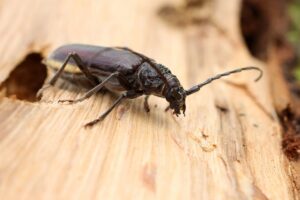Holzwurm vs. Wood: Understanding the Enemy Within

In the world of woodworking, the term “Holzwurm” sends shivers down the spines of craftsmen and homeowners alike. This seemingly innocuous word carries the weight of a formidable adversary to wood itself. In this article, we will delve into the enigmatic realm of Holzwurm, exploring its nature, its impact on wood, and the solutions that can help safeguard your prized wooden possessions. So, what exactly is Holzwurm?
Unveiling Holzwurm: The Woodworm Menace
Holzwurm, a German term for woodworm, refers to various species of wood-boring insects that have a voracious appetite for wood. These tiny but tenacious creatures can wreak havoc on wooden structures, furniture, and artifacts, making them a common adversary for wood enthusiasts and professionals. But what makes Holzwurm so destructive?
The Silent Invaders: Holzwurm Infestation
Holzwurm infestations often go unnoticed until significant damage has already occurred. These wood-boring insects lay their eggs in cracks and crevices of wood, where they hatch into larvae that tunnel through the timber, feeding on its cellulose content. Over time, this process can weaken the wood’s structural integrity, potentially leading to costly repairs or replacements.
Identifying Holzwurm Damage
Detecting Holzwurm damage early is crucial. Look for telltale signs such as small exit holes in the wood’s surface, fine powdery dust, or even the presence of adult beetles. Prompt identification can help mitigate the extent of the damage and prevent further destruction.
Types of Holzwurm
There are several species of wood-boring insects that fall under the Holzwurm umbrella. The most common ones include the Anobium punctatum (common furniture beetle), Hylotrupes bajulus (European house longhorn beetle), and the Lyctus brunneus (powderpost beetle). Each of these species has its unique characteristics and preferences when it comes to the type of wood they infest.
The Battle Against Holzwurm
Now that we’ve uncovered the threat Holzwurm poses, let’s explore ways to protect your wooden assets and spaces.
Prevention is Key
Preventing Holzwurm infestations starts with proper wood storage and maintenance. Ensure that wood is well-ventilated and not in direct contact with damp or moist areas, as these conditions are conducive to woodworm activity. Regular inspections of wooden items and structures can help catch infestations in their early stages.
Professional Help: Holzwurmer.com
For those in need of expert assistance, holzwurmer.com is a reputable service that specializes in Holzwurm prevention and treatment. Their experienced team can assess the extent of infestation and recommend effective solutions to eradicate the woodworm menace.
Natural Remedies
Some DIY enthusiasts prefer natural remedies to combat Holzwurm. This includes using essential oils like cedarwood, which can act as a deterrent, or applying boron-based treatments to the wood, making it less appetizing to wood-boring insects.
Holzwurm’s Long-term Effects
The insidious nature of Holzwurm infestations lies in their long-term consequences. If left unchecked, these wood-boring insects can compromise the stability of wooden structures over time. For homeowners, this can translate into costly repairs and renovations to ensure the safety and integrity of their homes. Additionally, antique collectors and enthusiasts may find that their cherished wooden artifacts are at risk, with potential damage that could diminish their historical and monetary value.
Holzwurm and Environmental Considerations
Beyond the immediate concerns of property damage, Holzwurm infestations also raise environmental questions. Wood is a valuable and sustainable resource when managed responsibly, but when it falls prey to woodworm, it can lead to a significant waste of this precious material. Sustainable forestry practices and proactive measures to protect wood from Holzwurm are essential steps in preserving both wooden assets and the environment.
In conclusion, the battle between Holzwurm and wood is an ongoing struggle that demands vigilance and action. By understanding the threat posed by these wood-boring insects and taking appropriate preventive measures, we can ensure that our wooden possessions and structures stand the test of time, all while minimizing the environmental impact of woodworm damage.
In the eternal battle of Holzwurm vs. Wood, knowledge is your greatest ally. By understanding the nature of this woodworm menace and taking proactive measures, you can protect your wooden treasures from their destructive clutches. Whether it’s prevention, professional assistance, or natural remedies, the key is to act swiftly to safeguard your wood.
How do I know if my wood is infested with Holzwurm?
Detecting a Holzwurm infestation can be crucial for early intervention. Keep an eye out for small exit holes in the wood’s surface, usually about the size of a pinhead. These holes are where adult Holzwurm beetles emerge. Additionally, check for powdery dust, which is often a byproduct of their tunneling activities. If you notice these signs or even the presence of adult beetles on or around the wood, it’s a strong indication of an infestation. Early detection is essential because addressing the problem promptly can prevent further damage.
Can I get rid of Holzwurm on my own?
While there are some DIY methods for dealing with Holzwurm infestations, it’s typically best to seek professional assistance, especially if the infestation is extensive or in valuable wooden structures. Professionals like holzwurmer.com have the expertise and tools to effectively and permanently eliminate these wood-boring pests. They can also assess the extent of the damage and provide recommendations tailored to your specific situation, ensuring a thorough and lasting solution.
What types of wood are most vulnerable to Holzwurm infestations?
Holzwurm infestations can target various types of wood, but they are particularly attracted to environments with high moisture levels. Woods that are damp or kept in areas prone to humidity are more vulnerable. Common targets include softwoods like pine and spruce, as well as hardwoods such as oak and walnut. To protect your wood from Holzwurm, it’s crucial to store it in well-ventilated, dry conditions.
Are there eco-friendly ways to combat Holzwurm?
Yes, there are environmentally friendly methods to deter Holzwurm infestations. One option is to use cedarwood essential oils, which can act as a natural repellent. Applying boron-based treatments to the wood is another eco-friendly choice. Boron is a naturally occurring element and can make the wood less appetizing to wood-boring insects. These methods are safer for the environment compared to some chemical alternatives.
Why is Holzwurm such a threat to wood?
Holzwurm larvae are a significant threat to wood because they tunnel through it, feeding on its cellulose content. Cellulose is the primary structural component of wood, providing its strength and rigidity. As Holzwurm larvae create tunnels and consume cellulose, they weaken the wood’s structural integrity over time. This weakening can lead to structural failures, making it a substantial concern for both homeowners and those who value wooden artifacts and structures. Addressing Holzwurm infestations promptly is essential to prevent extensive damage and preserve the integrity of the wood.






